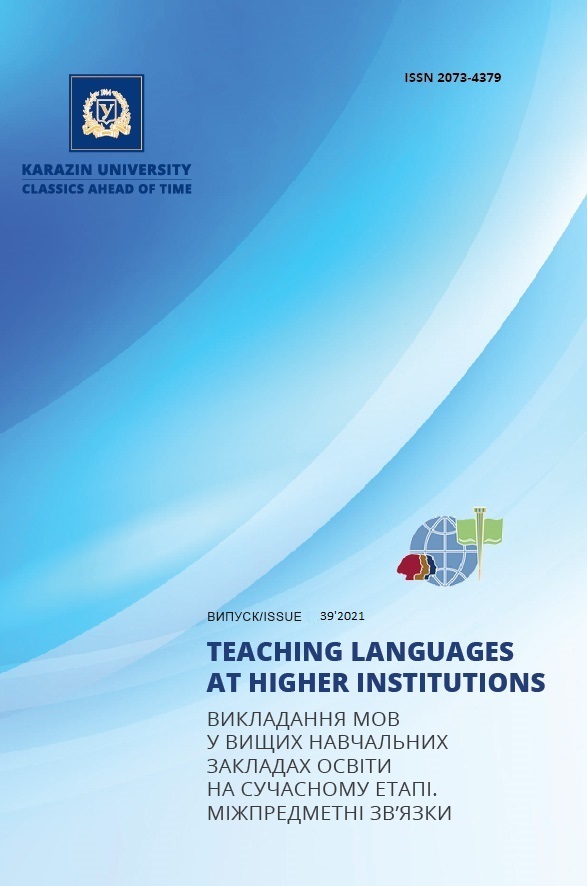The potential of using creolized texts in teaching languages to foreign students (demonstrated on Internet memes)
Abstract
One of the challenges facing a modern foreign language teacher is both a relatively low level of initial language training of educational migrants and their low motivation in studying the entire system of a foreign language and their involvement in the educational process. One of the ways to solve this problem is the system of working on creolized texts.
The creolized text (also called the polycode, or multimodal text) as a type of text that combines verbal and iconic information, is familiar to modern students from different countries, and fits into the world postmodern reality. Most often, creolized texts are spoken of in the analysis of advertising products, posters, or film texts. At the same time, for foreign language teachers, the use of polycode texts is by no means a novelty: you can at least name cards, posters, illustrations, picture dictionaries, and other means used at the initial stage. These verbal-iconic means have proven their unconditional effectiveness both in explaining lexical and grammatical material and in reinforcing what has been learned.
Reading a creolized text allows for the transition from text to meaning: such an algorithm allows an applicant for higher education to comprehensively use reception, memory, intelligence, and activate speech-thinking processes in a foreign language.
One of the most glowing functional types of creolized texts today is the meme – a special kind of multimodal text, closely welded verbal and iconic components that have a basic set of features: repeatability, comicality, recognizability, relevance. The use of memes in teaching foreign languages is an important way to increase the motivation of educational migrants to study, to establish intercultural communication, to form students’ linguistic and cultural competence, to facilitate the processes of adaptation and socialization in the new reality. Such texts may well become one of the sources of information about the national and cultural characteristics of a foreign country and its native speakers.
Downloads
References
Anisimova, E.E. (2003). Lingvistika teksta i mezhkulturnaya kommunikatsiya (na materiale kreolizovannykh tekstov) [Linguistics of the text and intercultural communication (based on creolized texts): a textbook for students of faculties of foreign languages of universities]. Moscow: Izdatelskiy tsentr “Akademiya” [in Russian].
Bakhtin, M.M. (1986). Literaturno-kriticheskiye statyi [Literary critical articles]. Moscow: Khudozhestvennaya literatura [in Russian].
Bernatskaya, A.A. (2000). K probleme “kreolizatsii” teksta: istoriya i sovremennoye sostoyaniye [On the problem of “creolization” of the text: history and current state]. Rechevoye obshcheniye: Spetsializirovannyy vestnik [Speech communication: Specialized messenger]. Skovorodnikov, A.P. (ed.). Krasnoyarsk, 3 (11), pp. 104–110 [in Russian].
Valgina, N.S. (2003). Teoriya teksta [Text theory]. Moscow: Logos [in Russian].
Grigoryeva, E. (2014). Creolized Texts in Intercultural Communication. W kręgu zagadnień semantyki i stylistyki tekstu [On the issues of semantics and style of the text]. Blyumental, I., Pyasetska, A. (eds.). Wydawnictwo Uniwersytetu ódzkiego, ódź 2014, pp. 47–53 [in Russian]. DOI: https://doi.org/10.18778 / 7969-416-7.05.
Zagoruyko, A.O. and Efremova, M.A. (2019). The Value of Internet Memes as a Teaching Aid. Teaching Methodology in Higher Education. 2019. Vol. 8, No 28, pp. 12–21 [in Russian]. DOI: https://doi.org/10.18720 HUM/ISSN 2227-8591 28.01.
Zalesskaya, N.A. (2020). Rol internet-memov v obuchenii inostrannomu yazyku [The role of Internet memes in teaching a foreign language]. Lingvistika, lingvodidaktika, lingvokulturologiya: aktualnyye voprosy i perspektivy razvitiya: materialy IV Mezhdunar. nauch.-prakt. konf. Minsk. 19–20 marta 2020 g. [Linguistics, linguodidactics, cultural linguistics: topical issues and development prospects: materials of the IV intern. scientific-practical conf., Minsk, March 19–20, 2020]. Prokhorenko, O.G. (ed.). Minsk: BGU, pp. 198–202 [in Russian].
Zakharova, O.O. (2021). Motivating potential of internet-memes in the foreign language learning with engineering university students. Tomsk State Pedagogical University Bulletin. 2 (214), pp. 7–16 [in Russian]. DOI: https://doi.org/10.23951/1609-624X-2021-2-7-16.
Іnstagram account «in_ukraine_we_dont_say». URL: https://www.instagram.com/in_ukraine_we_dont_say/ (Accessed on August 17, 2021) [in Ukrainian].
Kozdra, M. (2018). Multimodalnost v obuchenii russkomu yazyku kak inostrannomu [Multimodality in teaching Russian as a foreign language]. Aktualnyye voprosy opisaniya i prepodavaniya russkogo yazyka kak inostrannogo/nerodnogo: sbornik materialov Mezhdunarodnoy nauchno-prakticheskoy internet-konferentsii (Moskva. 27 noyabrya – 1 dekabrya 2017 g.) [Topical issues of describing and teaching Russian as a foreign/non-native language: a collection of materials of the International Scientific and Practical Internet Conference (Moscow, November 27 – December 1, 2017)]. Kulibina, N.V. (ed.). Moscow, pp. 509–517 [in Russian].
Kuzmina, E.O. (2019). Ispolzovaniye polikodovykh tekstov v obuchenii RKI na nachalnom etape [The use of polycode texts in teaching RFL at the initial stage]. Nauka i shkola [Science and school]. 1, pp. 118–123 [in Russian].
Pisar, N.V. (2020). Internet-memy kak sredstvo formirovaniya lingvostranovedcheskoy kompetentsii pri obuchenii inostrannykh studentov i slushateley russkomu yazyku [Internet memes as a means of developing linguistic and cultural competence in teaching Russian to foreign students and listeners]. Pedagogika. Voprosy teorii i praktiki [Pedagogy. Issues of theory and practice]. 5, 3, pp. 326–331 [in Russian].
Popova, T.I., Kolesova, D.V. (2020). Polycode vs verbal text in academic lecture discourse. Society. Communication. Education. 11 (3), pp. 78–87 [in Russian]. DOI: https://doi.org/10.18721/JHSS.11306.
Sergeyeva, Yu.M., Uvarova, E.A. (2014). Polikodovyy tekst: osobennosti postroyeniya i vospriyatiya [Polycode text: features of construction and perception]. Nauka i shkola [Science and school]. 4, pp. 128–134 [in Russian].
Sorokin, Yu.A. and Tarasov, E.F. (1990). Kreolizovannyye teksty i ikh kommunikativnaya funktsiya [Creolized texts and their communicative function]. Optimizatsiya rechevogo vozdeystviya [Optimization of speech impact]. Moscow: Vysshaya shkola, pp. 180–186 [in Russian].
Filonova, E.A. (2021). Ispolzovaniye memov v protsesse obucheniya inostrannomu yazyku [Using memes in the process of teaching a foreign language]. Materialy XIV Mezhdunarodnoy nauchnoy konferentsii «Obshchestvo: nauchno-obrazovatelnyy potentsial razvitiya (idei. resursy. resheniya)» [Materials of the XIV International Scientific Conference «Society: Scientific and Educational Development Potential (Ideas, Resources, Solutions)»]. Cheboksary, pp. 111–116 [in Russian].

